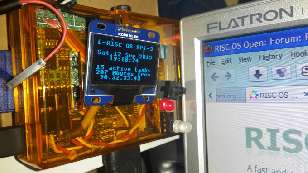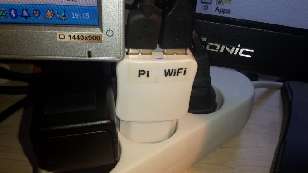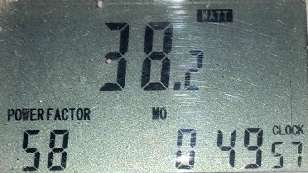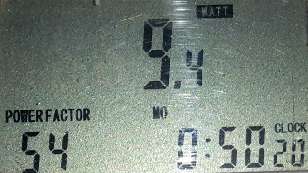Rick's b.log - 2015/09/12
You are 3.138.105.4, pleased to meet you!
Rick's b.log - 2015/09/12 |
|
| It is the 24th of November 2024 You are 3.138.105.4, pleased to meet you! |
|
mailto: blog -at- heyrick -dot- eu
The setup is fairly simple. Here is the Pi itself:
The video is handled by way of a little HDMI to VGA adaptor I got from eBay for about €14 all in. It was originally powered from the HDMI port, but given that it required rather more than the 50mA that the Pi was happy to source (judging by how quickly the Pi's supply diode got worryingly hot), I modified it to run off of a USB supply.
Connectivity is handled by a Vonets VAP11G. This needed a special setup program that runs on Windows XP (later adaptors appear to have some sort of web configuration built in). Once set up to recognise my ADSL router's access point and know its password, it just connects automatically once it is powered up. It deals with WiFi and "pretends" to be the Pi (offering the Pi's MAC address as its own) and acts as a bridge between the Pi's ethernet socket and WiFi. Running with RaspBMC, it easily manages around 260KiB/sec which is maxing out my 2mbit ADSL connection; though for some reason RISC OS never seems to be able to go much beyond ~160KiB/sec.
All of this is powered as follows:
And now, for the moment of truth.
The Pi, with the display operating, consumes this much electricity:
Which leads us on to:
But wait, we can actually do better. No, for real. You'll have noticed that the HDMI adaptor is plugged into its own power supply. Well, fine. Pop that out of its socket. Let's face it, the time when I'm going to want to see the display is the time when I am programming, or actually using the machine. All other times... if the monitor is off, why power the HDMI adaptor?
In reality, unless it is a set-it-and-forget-it server, you should probably factor on around €12-18 per year as there will be times when you would want to actually use the Pi. However since I'm sitting here with the Pi running (7.7W), my EeePC (20W) hooked to a 19" widescreen flat panel monitor (31W), the Livephone charger (2W), and the desk lamp (40W) - all totalling a shade over 100W, I don't need to feel any guilt or worry about leaving the Pi running. I could run it for ten whole hours for the cost of every hour of what I'm consuming now (including correction for the fact that it is on right now). And don't get me started on the 2.2KW consumed by the kettle I've just switched on. It took about 5 minutes, at 2.2KW, actually, that can be your homework - figure out how long the Pi could run for the power that I consumed making a cup of tea...
The efficiency of a Pi server
I have my Pi (original issue 2 Model B with 256MiB RAM) running a server (WebJames and custom) under RISC OS; though I would imagine the power consumption would be comparable with Raspian or the like.

The white/green/black wires connected to the Pi (upper left) are for the USB serial interface. It can be useful for debugging to have a running commentary appear on the PC. The disconnected red wire is a 5V source taken from the USB port. There is no need for it as the Pi's I/O runs at 3.3V. The ribbon cable wires soldered to the RTC board are for the OLED display (and I wrote the driver for that too), it runs off 3.3V and communicates via IIC.
The push-button you can see is a programmer's best friend. It is connected to the Pi's reset pins. It is a friendlier way to reset than power cycling (and is thus less likely to trash data on SD cards). For those times when you're in SVC mode and you forget to stack R14 around making SWI calls...

The monitor is an IISonic IIMJ7 17" TFT monitor with a native resolution of 1280×1024 (4:3 aspect). Neither the Pi nor RISC OS have any trouble with this. The Pi is extremely friendly in this respect - unlike the Beagle xM with which I struggle to get any sort of stable display. At any rate, it provides a standard VGA socket to which practically any VGA-style analogue monitor can be connected. The output is sharp and stable and clear.



The Pi with it's monitor? It will run like that for about 26 hours for the equivalent of one unit of electricity. I'm judging a unit to be approximately €0,12 with taxes and service charge factored in, though there are many different tariffs so it is a guideline. This does imply that the price of running this setup will be around €40 per year, but be realistic, this means never turning the monitor off. Most domestic users are going to be less wasteful.

With this in mind, using a Pi model B and a Vonets VAP11G, it is possible to run a server for... ta-dah!

That's right.
Seven point seven watts. My EeePC's charger takes more than that. Hell, I think the Livebox takes more than that, and its supposed to be kept on all the time (just tried it, the spare Livebox when not connected to the phone line consumes about 8.4W, that would likely rise slightly when the ADSL transceiver is enabled).
Or to put it into context, your unit of electricity would give you 130 hours of use; or an approximate cost of €8 in a year.
David Pilling, 16th September 2015, 13:42 Rick, 16th September 2015, 15:32 Rick, 27th September 2015, 15:50 jhon.chris, 9th October 2019, 11:07
An LED Display unit itself is a final consumer, no data.
<a href="https://dynamo-led-displays.co.uk/led-video-walls/">LED</a> Display Unit is more commonly called the 7-segment LED.Alan, 30th March 2020, 16:02
| © 2015 Rick Murray |
This web page is licenced for your personal, private, non-commercial use only. No automated processing by advertising systems is permitted. RIPA notice: No consent is given for interception of page transmission. |